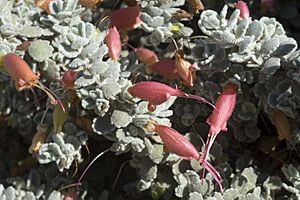Hill's emu bush facts for kids
Quick facts for kids Hill's emu bush |
|
|---|---|
 |
|
| Conservation status | |
| Scientific classification | |
| Genus: |
Eremophila (plant)
|
| Species: |
hillii
|
Eremophila hillii, also known as Hill's emu bush, is a beautiful flowering plant. It belongs to the figwort family, called Scrophulariaceae. This plant is special because it is endemic to the Nullarbor Plain in Australia. This means it naturally grows only in that area.
Hill's emu bush is a thick shrub with many tangled branches. Its stems, leaves, and sepals are very hairy. The plant produces pretty red or yellow petals.
Contents
What it Looks Like
Hill's emu bush is a thick shrub that can grow upright or spread out. It usually reaches a height of less than 0.8 meters (about 2.6 feet). Its branches are covered with white or light grey branched hairs when they are young. As the plant gets older, these branches become smooth.
The leaves grow close together near the ends of the branches. When they are young, they are also covered in dense hairs. Later, they become smooth. The leaves are usually 8 to 18 millimeters (about 0.3 to 0.7 inches) long and 4 to 10 millimeters (about 0.16 to 0.4 inches) wide. They are egg-shaped or almost round. Often, they have a few rounded teeth along their edges.
Flowers and Fruits
The flowers of Hill's emu bush grow one by one where the leaves meet the stem. Each flower sits on a very hairy stalk that is 1 to 4 millimeters (about 0.04 to 0.16 inches) long. There are 5 sepals, which are like small leaves that protect the flower bud. These sepals vary in size and shape, from long and thin to egg-shaped. They are mostly 4 to 16 millimeters (about 0.16 to 0.63 inches) long.
The petals are 20 to 35 millimeters (about 0.8 to 1.4 inches) long. They are joined at the bottom to form a tube. This petal tube is usually red or orange-red, but sometimes it can be yellow. Both the inside and outside of the tube have tiny hairs that produce sticky substances, called glandular hairs. The four stamens, which are the parts that produce pollen, stick out beyond the end of the petal tube.
Hill's emu bush flowers from July to September. After flowering, it produces fruits. These fruits are dry and oval-shaped. They have a smooth, papery covering and are 5.5 to 7.5 millimeters (about 0.22 to 0.3 inches) long.
Plant Name and History
This plant was first officially described in 1967 by a scientist named Elizabeth Anne Shaw. Her description was published in a scientific journal called Transactions of the Royal Society of South Australia. The second part of its scientific name, hillii, was chosen to honor Ronald Hill. He worked at the Adelaide Botanic Garden.
Where it Lives
E. hillii grows in stony clay and calcareous soils. Calcareous soils are rich in calcium carbonate, like limestone. You can find this plant in separate groups on the Nullarbor Plain. It grows in both South Australia and Western Australia.
Protecting the Plant
The Government of Western Australia's Department of Parks and Wildlife has given Eremophila hillii a special classification. It is listed as "Priority Four". This means the plant is rare or nearly threatened, so it needs to be protected.
Growing Hill's Emu Bush
Hill's emu bush is a tough and dependable shrub for gardens. Some plants have been grown in gardens for as long as 40 years! The bright red and orange-yellow types look really good when planted next to each other.
It's easy to grow new plants from cuttings. Cuttings are small pieces of the plant that can grow roots. This plant can grow in many different types of soil, even clay. However, it prefers a sunny spot. It can also handle dry conditions and is resistant to frost.


